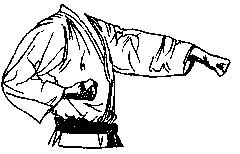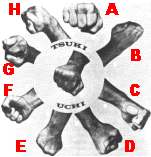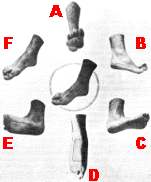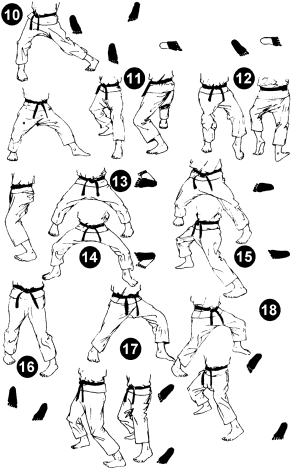Originally KARATE is a method of self-defense. Parts of the body are used as a natural weapon to hit, to kick or to push on vital parts of the body of the opponent.
KARA |
means |
EMPTY |
TE |
means |
HAND |
KARATE |
literately
means |
EMPTY HAND |
During the sixth century DARUMA, founder of the ZEN BOUDHISM, left WEST-INDIA and travelled to China. Once there, he developed a new training method for the monks, who were weakened due to the many meditation sessions. After a period of time, this method seemed to work very well and the monks became flexible and strong.
The monks travelled a lot and were often robbed of the few things they had in their possession.
Because they were well trained physically, they were able to counterattack most of the robbers. This turned the training technique they had learned into a fight technique.
Because of its success, the method was passed on to all monks and the SHORIN-JI KEMPO method was born. It reached OKINAWA during the 15th century (at that moment still China), where it was called OKINAWA-TE. Everywhere it was trained in all secrecy due to the Japanese invasion. The Japanese had forbidden all weapons and meetings in order to abolish all possible resistance.
Only in 1906, the first demonstrations of the technique took place. They were called SHORIN-RYU and SHOREI-RYU.
In 1916 G.FUNAKOSHI demonstrated HIS METHOD in TOKYO, with enormous success, also because G.Funakoshi was a very short man. The power he showed was so enormous that he was asked to stay in Tokyo.
Only in 1922 he came to live in Tokyo, where he developed together with his son YOCHITAKA, the well-known SHOTOKAN Karate. We can say that this little man is the founder of the Karate we know now.
In 1929, MABUNI came to Osaka and taught his training method, which he called SHITO-RYU.
MIYAGI settled in Kyoto with his GOJO-RYU method.
In 1935, WADO-RYU was founded with OTSUKA.
In the same period SAWAYAMA founded his KEMPO-RYU.
During World War II, all martial arts were forbidden by the invasion (repetition of history?).
It was only in 1948 that the restraining order was abolished. Only four main Karate styles were left over, namely: SHOTOKAN-WADO-SHITO-GOJU RYU.
After this period some people thought that there were shortcomings in one style and this was a reason for the foundation of new styles:
OKYAMA developed KYOKUSHIN KAI
TAMI the scientific SHUKO KAI.
NANBU his SANKU KAI and later on NANBU KAI.
The SHOTOKAN style was separated to SHOTO KAI.
In this way, different styles with all the same roots were
founded. The style, however, is not that important. Karate
is much more than just a movement. The power of a fist technique
is the same in every style, the defense must happen quickly
and correctly.
Never be influenced by someone telling you his or her technique is better than yours. Each style has his own pro and cons.
Karate has worldwide known an enormous growth.
In this way the Japanese Karate Association, J.K.A. was founded in Japan.
In 1963 the EUROPEAN KARATE UNION, E.K.U., was founded in Paris. But only in 1970 it was called WORLD UNION KARATE DO ORGANIZATION - W.U.K.O. - and kept its name only during the first WORLD CHAMPIONSHIPS. The name changed its name in 1994 to W.K.F. or WORLD KARATE FEDERATION.
In 1985 thanks to W.U.K.O., Karate was recognized by the OLYMPIC COMITY.
On national level, for a small country as Belgium, Karate is very well represented. There are approximately 30.000 Karatekas in the different associations.
The "Belgische Karate Associatie" (B.K.A.) is divided in two wings: The "Vlaamse Karate Associatie" (V.K.A.) and "The Ligue Francophone du Karate".
The V.K.A. is a style group from the "Vlaamse Karate Federatie" (V.K.F.).
The V.K.F. is a member of the "Belgische Karate Federatie", E.K.U. and W.K.F.
The V.K.F. has two wings, the "Vlaamse Karate Associatie" (V.K.A.) and the "Vlaamse Karate Vereniging" (V.K.V.). V.K.V. is a member of the "Japan Karate Association" (J.K.A.).
The difference between organizations, J.K.A. and W.K.F. is that the J.K.A. uses the IPPON SHOBU (one score) system.
The W.K.F. however, uses the more modern version of scoring more points during a game.
Since 01/01/92 the B.K.F. was founded. This is the head organ for both parts of the country.
This cooperation is necessary to be able to come forward with the association on Belgian level. This organization is also recognized by B.L.O.S.O./B.O.I.C., E.K.U. and W.K.F.
The room or space where Karate is practised is called "DOJO". In the Dojo there is complete silence. The only person talking is the instructor or in Japanese terms the "SENSEI". The pupils or Karatekas have to be at the training in time. Those who are late have to ask permission to the Sensei before entering the lesson.
When entering or leaving the Dojo, one must greet.
The Dojo is only left with permission of the Sensei.
THE KARATEKAS.
have a neat haircut
short nails
no earrings or other jewelry
the karate-gi or training outfit has to be clean
trainings happen barefoot
women are wearing a T-shirt under the training outfit
TRAINING OUTFIT.
The training outfit of a Karateka exists of a pair of trousers and a vest. These have to be white and of a good quality. Filthy clothes are not allowed during training. The Karate-gi is the correct name for the training outfit. After buckling up the vest, a belt is worn. On this belt we can read the degree of knowledge of the Karateka.
GRADUATIONS.
In Dai Nippon the traditional form is kept. We do not know yellow, green, etc. graduations.
A beginner starts with a complete white belt. After a month or three he/she is examined by the Sensei. If he/she succeeds he gets the 8th kyu degree (apprentice degree). The belt is marked with a little black stripe.
The next examination takes place after a certain number of training sessions. If he/she succeeds, he/she gets the 7th kyu degree and a second little black stripe on the belt.
ATTENTION, from the 3rd kyu on the color of the belt and the little stripe changes, into a brown belt with little white stripes. As 1st kyu he/she has 3 little white stripes.
Youth examinations are divided in Candidate and kyu (red stripes).
Al these examinations are taken at the club. The program becomes more and more difficult.
After a year being 1st kyu the teacher can propose the pupil for the 1st DAN Black Belt. This examination is taken before a National Jury.
If he/she succeeds he/she becomes the first master degree. DAN means master degree.
To obtain a DAN degree, we must wait the number of years the DAN degree counts plus 1 year extra.
GREETING,
The greeting takes place while entering or leaving the Dojo,
at the beginning or ending of the lesson. The greeting can
happen standing up as well as sitting down.
STANDING GREETING
Normal standing up, feet together hands near the body. The upper corps slightly bows forward, the eyes focussed forward. Do not close the eyes; always keep your opponent in focus.
THE SITTING GREETING.
We kneel down, in complete balance; we sit on the ball of the feet.
FIRST THE SENSEI, THAN THE PUPILS.
The left knee is placed on the floor, the right one follows. The left hand is placed in the middle on the ground, the right hand follows. The head is bent forward between the two hands. This position is kept on during 3 counts. The return to the starting position happens in the opposite direction, keeping the same ritual in mind.
A training starts with a traditional greeting. After the given order to stand in a circle or block starts the:
Warming up: |
All muscles are warmed up in a very specific and accurate manner. Exercises are given power, flexibility, resistance, coordination and endurance.
|
KIHON: |
Group training.
|
KUMITE: |
Exercises learned during the Kihon session are now practised with partner or opponent, in order to learn to measure the right distance and direction. One step further in Kumite is:
|
KATA: |
These are exercises in style, which determine through their characteristics, the rank of knowledge of the karateka. A Kata is a series of set movements, positions, punches en kicks that have to be performed in the same way by every practitioner. If for example, de first Kata is performed. It will be done in the same style in Belgium, as well as in Italy, Iceland or wherever. In the SHOTOKAN style we know 26 Katas.
|
TAMESHIWARA or breaking technique: |
Someone who is a practitioner for years
wants to test his own capacities and see if his techniques
are efficient enough. On the body of the partner he
can not use his full power. In order to see if a practitioner
uses a good technique, he can try this on wood, stones,
bricks, etc.... |
DURING THE TRAINING SESSION:
During the training session we do not talk. When working with a partner, this must be done with complete control and discipline. After the end greeting the Dojo is left in complete silence and also the entering of the dressing rooms is done with a complete discipline, as well as taking a shower. It is important to take the sport-bag with all valuables in it with you into the Dojo.
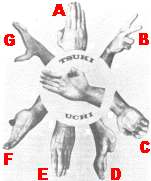 |
A) Nukite B) Nukite C) Kumade D) Haito E) Haishu F) Shuto G) Hirabamasi |
Tsuki (Vooraanzicht) |
|
Tsuki (Zijaanzicht) |
|
A) Kentos B) Hiraken C) Testtsui D) Ura Tettsui E) Uraken F) Hei-ken G) Nakadaka-ken H) Ippon-ken |
|
 |
Uchi-uke & Gyaku-tsuki |  |
Gedan-barai Kamai |
 |
Yoko-Geri Kekomi |
|
A) Koshi B) Sokuto C) Kakato D) Heisoku E) Teisoku F) Ashi-no-ura |
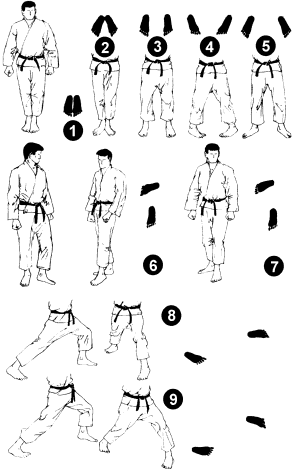 |
1) Heisoku dachi 2) Musubi dachi 3) Heiko dachi 4) Uchi Hachiji dachi 5) Hachiji dachi 6) Teiji dachi 7) Renoji dachi 8) Zenkutsu dachi 9) Gyaku-zuki-no-dachi |
| 10) Gyaku-zuki-tsukomi-no-dachi 11) Kokutsu dachi 12) Neko-achi-dachi 13) Kiba dachi 14) Shiko dachi 15) Seichan dachi 16) Sanchin dachi 17) Tate Seishan (Wado) 18) Fudo / Sochin dachi |
|
|
|
A Kata is a series of set movements, positions, punches en kicks that have to be performed in the same way by every practitioner. In the SHOTOKAN style we know 26 Katas. |
| Japans | English |
| Age | Upward |
| Age-tsuki | Rising punch |
| Age-uke | Upward block |
| Ate | Strike |
| Chudan | Midsection |
| Chudan-tsuki | A punch to the midsection of the opponent's body |
| Dan | Level, Rank, Degree |
| Empi-uchi | Upward elbow strike |
| Fumi-komi | Stomp kick |
| Gedan | Lower section |
| Gedan-barai | Downward block |
| Geri | Kick |
| Geri-waza | Kicking technique |
| Gichin Funaokoshi | Founder of the modern Karate |
| Gyaku-tsuki | Reverse punch |
| Haito-uchi | Ridge-hand strike |
| Heian 1 - 5 | Five fundamental katas |
| Hiji-ate | Elbow strike |
| Hiza-geri | Knee kick |
| Hiza-uke | A blocking action using the knee |
| Jiyu-kumite | Free sparring |
| Jodan | Upper level |
| Jodan-tsuki | Fist attack on the face |
| Juji-uke | X block |
| Kagi-tsuki | Hook punch |
| Kakato-geri | Heel kick |
| Kansetsu-geri | Kick on knee |
| Karategi | Training costume |
| Karateka | A practitioner of Karate |
| Kata | Fixed form, exercise on style |
| Ken | Fist, sward |
| Kiba-dachi | Staddle stance |
| Kihon | (Something) fundamental. Basic techniques |
| Koken-uchi | Wrist joint technique attack |
| Koken-uke | Wrist joint technique block |
| Kokutsu-dachi | Back stance |
| Kumite | Fight practice with partner |
| Mae-geri | Front kick |
| Mae-tobi-geri | Front snap kick |
| Makiwara | |
| Mawashi | Roundhouse |
| Mawashi-geri | Roundhouse kick |
| Mawashi-tsuki | Roundhouse punch |
| Mawashi-uke | Roundhouse block |
| Mikatsuki-geri | Crescent kick |
| Mikatsuki-geri-uke | U punch |
| Morote-tsuki | Augmented block |
| Morote-uke | Two handed block |
| Nagashi-uke | Sweeping block |
| Nekoashi-dachi | Cat stance |
| Nukite | Spear hand |
| Oi-tsuki | Lunge punch |
| Seiken | Fore fist |
| Seiken-choku-tsuki | Fore fist straight punch |
| Shotei-uchi | Palm heel attack |
| Shotei-uke | Palm heel block |
| Shuto | Knife hand |
| Shuto-uchi | Knife hand attack |
| Shuto-uke | Knife hand block |
| Soto(ude)-uke | Block from outside inward |
| Taikyoku 1 - 3 | Katas |
| Tameshiwari | Breaking techniques |
| Tate | Straight |
| Tettsui-uchi | Hammer attack |
| Tekki 1 - 3 | Katas |
| Tsuki | Punch |
| Uchi | Inside attack |
| Uchi(ude)-uke | Inside block |
| Uke | Blocking |
| Ura-ken-uchi | Block knuckle |
| Ura-tsuki | Short punch |
| Ushiro-geri | Back kick |
| Waza | Techniques |
| Yoko-geri | Side kick |
| Yoko-tobi-geri | Side jumping kick |

